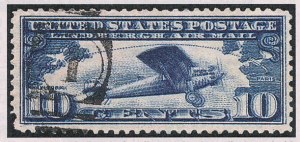
One of the most exciting things in philately is when there is a new discovery of a major variety on a well known and avidly collected stamp. Such a find was reported in the January 10 edition of Linns on the ten cent Lindbergh stamp of 1927 (Scott #C10). This stamp sells for about $10 mint and about 20c used and is a mainstay of most US collections and collectors. It has always been a stamp that is just scarce enough for a newer collector to aspire to acquiring but not scarce enough to be difficult to afford. This discovery is a major variety- a true double impression which occurs when the plate is brought down twice on the paper. A single was discovered used and with a variety of this type a single means that the entire sheet of four panes of fifty were printed this way and thus at least 200 must have existed at one time. Errors of this type are easy to miss and the fact that this error is used means that the sheets may have been sold into non philatelic hands where they were used on regular commercial mail. This accounts for the error taking 83 years to surface. The chance of finding another are slim but possible. When the 30c 1869 invert was discovered several years after it was issued, the publication of its discovery prompted several new “finds” as collectors looked more carefully at stamps in their possession. I would take a look at any old #C10 covers or singles that I had and would be attentive to any covers that I would see in dealer boxes or auction lots. Finding another one would be fun indeed.
Shopping Cart
